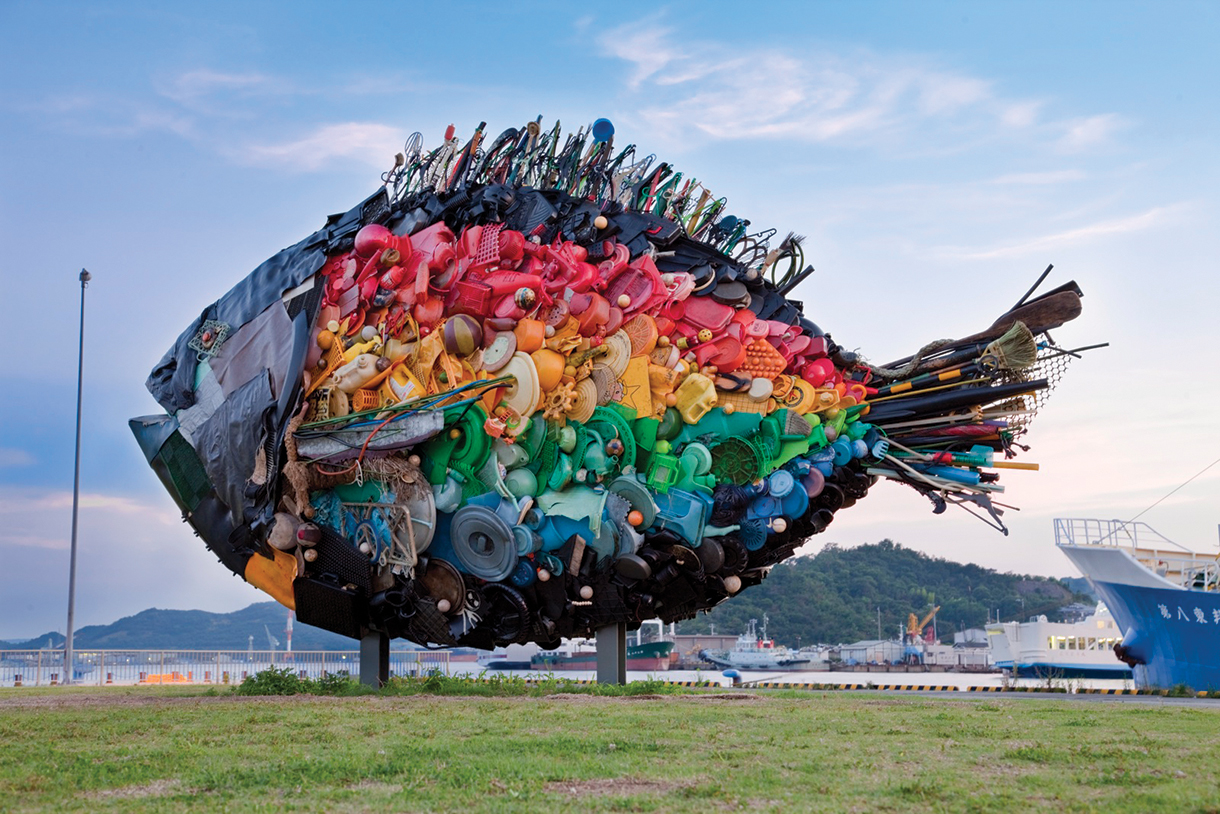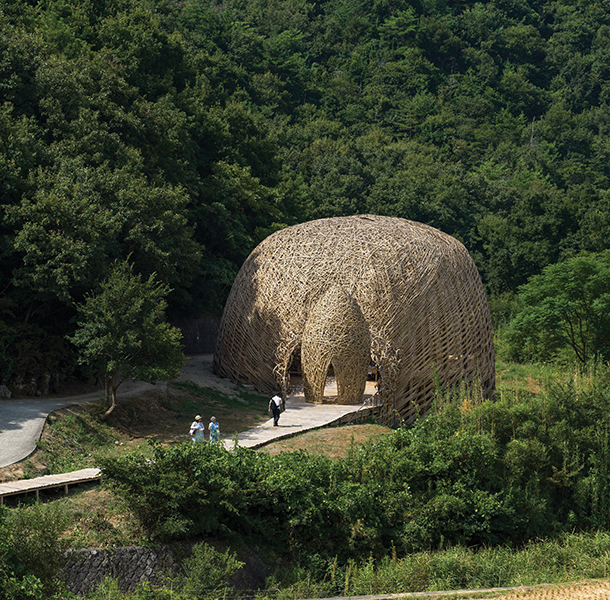
Black Porgy in Uno sculpture at the 2013 festival; a weave sculpture at the 2016 festival. Courtesy Setouchi Triennale
Culture
Setouchi Triennale Festival
Islands off the coast of Hiroshima in Japan host the fourth edition of one of the most anticipated fairs.
By Mark Ellwood
This year, the global art community has converged on an unlikely locale: a series of 12 islands dotted off the coast of Hiroshima in Japan, which are hosting the fourth edition of the Setouchi Triennale (setouchi-artfest.jp). The event happens just once every three years and is spread over three seasons: spring, summer, and fall. The most exciting art event in Asia would have been unthinkable 30 years ago, when its founder, collector Soichiro Fukutake, first mooted using art to boost the region out of the doldrums.
As Tomohiro Muraki, CMO for the region’s tourism authority, says, “this area was enshrined as Japan’s first national park in the 1930s but was pragmatically repurposed as an industrial base to help reboot the country in the wake of its defeat in World War II. Granite quarrying and copper smelting became staples.” The islands’ beauty was blighted by dumping, and the population leeched away as young people fled to find better lives in Tokyo or beyond. That’s when Fukutake, sailing through here in 1989, became determined to use his wealth—and burgeoning art collection—to kickstart a renaissance. He settled on the island of Naoshima as his proving ground, where he began working with minimalist starchitect Tadao Ando to develop an island-spanning complex known as Benesse (benesse-artsite.jp) that combined museums and hotels with public, site-specific artworks.
Once he established a foothold, Fukutake set about promoting his fiefdom to a wider audience via Triennale, the first of which took place in 2010. It aimed to leverage the festival using the area’s newfound cachet among the arterati to drive significant, upscale tourism from Japan and beyond. He and his team hoped to attract 300,000 or so visitors; almost 1 million made the journey and immediately established this artfest as a major must-see.
As Tomohiro Muraki, CMO for the region’s tourism authority, says, “this area was enshrined as Japan’s first national park in the 1930s but was pragmatically repurposed as an industrial base to help reboot the country in the wake of its defeat in World War II. Granite quarrying and copper smelting became staples.” The islands’ beauty was blighted by dumping, and the population leeched away as young people fled to find better lives in Tokyo or beyond. That’s when Fukutake, sailing through here in 1989, became determined to use his wealth—and burgeoning art collection—to kickstart a renaissance. He settled on the island of Naoshima as his proving ground, where he began working with minimalist starchitect Tadao Ando to develop an island-spanning complex known as Benesse (benesse-artsite.jp) that combined museums and hotels with public, site-specific artworks.
Once he established a foothold, Fukutake set about promoting his fiefdom to a wider audience via Triennale, the first of which took place in 2010. It aimed to leverage the festival using the area’s newfound cachet among the arterati to drive significant, upscale tourism from Japan and beyond. He and his team hoped to attract 300,000 or so visitors; almost 1 million made the journey and immediately established this artfest as a major must-see.

The Boat Piano on display at the port of Megijima Island. Courtesy Setouchi Triennale

A weave sculpture at the 2016 festival. Courtesy Setouchi Triennale
This year the festival’s three phases, each featuring unique displays and site-specific installations across the islands and two ports on the Seto Inland Sea, follow the theme Restoration of the Sea—a nod to the economic woes of the area that the Triennale aims to counter. Many of the artworks on show nod to the decay of communities across the region, especially from the brain drain that siphoned away younger residents. The final session, runs September 28 through November 4.
Though Naoshima forms part of the event, it isn’t the best base from which to explore—better to base yourself in Takamatsu, the central part on the major island of Shikoku and take day trips from there to any island. Aside from Naoshima and Benesse, don’t miss the Teshima Art Museum, a sister site to Benesse that’s a permanent feature on the namesake island. On nearby Megijima, the food artist Eat & Art Taro will be in residence throughout, creating delicious edible pieces—expect nods to the region’s reputation for superlative udon and the citrus fruits that thrive in the Mediterranean-like climate here, such as hassaku oranges.
During the final phase of the festival, the most in-demand area to visit with the greatest concentration of works is the western tranche of islands in the archipelago. Among the westernmost cluster, don’t miss Honjima, where untouched Edo period architecture rims the port; look for pieces like Bottom Sky and a netting and rope installation inspired by old ships or tiny Ibukijima. The farthest west of all, the island is barely a half square mile in size but already renowned throughout Japan for its anchovies. The fishing hub will be transformed via a dozen site-specific pieces installed among the ramshackle houses of the tiny village here.
Though Naoshima forms part of the event, it isn’t the best base from which to explore—better to base yourself in Takamatsu, the central part on the major island of Shikoku and take day trips from there to any island. Aside from Naoshima and Benesse, don’t miss the Teshima Art Museum, a sister site to Benesse that’s a permanent feature on the namesake island. On nearby Megijima, the food artist Eat & Art Taro will be in residence throughout, creating delicious edible pieces—expect nods to the region’s reputation for superlative udon and the citrus fruits that thrive in the Mediterranean-like climate here, such as hassaku oranges.
During the final phase of the festival, the most in-demand area to visit with the greatest concentration of works is the western tranche of islands in the archipelago. Among the westernmost cluster, don’t miss Honjima, where untouched Edo period architecture rims the port; look for pieces like Bottom Sky and a netting and rope installation inspired by old ships or tiny Ibukijima. The farthest west of all, the island is barely a half square mile in size but already renowned throughout Japan for its anchovies. The fishing hub will be transformed via a dozen site-specific pieces installed among the ramshackle houses of the tiny village here.




